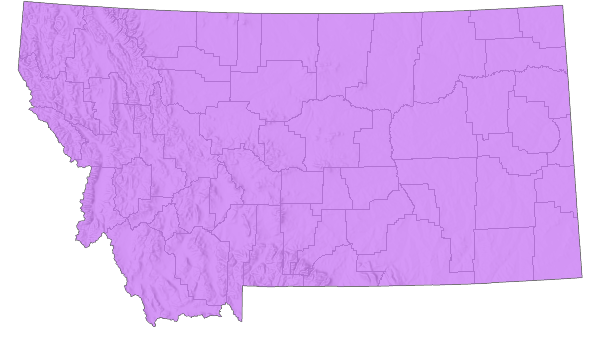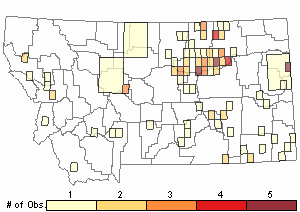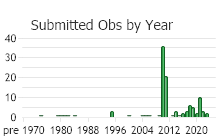View in other NatureServe Network Field Guides
NatureServe
Montana
Utah
Wyoming
Idaho
Wisconsin
British Columbia
South Carolina
Yukon
California
New York
Rough Cocklebur - Xanthium strumarium
Native Species
Global Rank:
G5
State Rank:
SNR
C-value:
3
Agency Status
USFWS:
USFS:
BLM:
External Links
General Description
Stems erect, strigose, 10–100 cm, . Leaf blades cordate-deltate, 2–12 cm long, serrate, sometimes shallowly few-lobed, sparsely short-hispid. Burs 2–4 cm long, 2-beaked, stipitate-glandular (
Lesica et al. 2012. Manual of Montana Vascular Plants. BRIT Press. Fort Worth, TX).
Our plants are variety
canadense (Mill.) Torr.& A.Gray
Diagnostic Characteristics
Xanthium strumarium is distinguished from spiny clotbur (X. spinosum) by its broader cockleburs, more ovoid leaves on long petioles, and lack of spines.
Species Range
Montana Range
Range Descriptions

 Native
Native
Range Comments
Xanthium strumarium is distributed worldwide (53 degrees north to 33 degrees south latitude) but is most common in the temperate zone (Love and Dansereau 1959). It is a serious weed in Australia, India, South Africa, and the Americas.
There has been considerable controversy regarding the origin of cocklebur. Though first described from Europe, it is probably of American origin (Munz and Keck 1973). Love and Dansereau (1959) suggest that the cocklebur subspecies most abundant in North America (cavanilliesii) originated in Central America. The dates of its introduction to California are not known, but it may be pre-Columbian.
Observations in Montana Natural Heritage Program Database
Number of Observations: 163
(Click on the following maps and charts to see full sized version)
Map Help and Descriptions
Relative Density

Recency



 (Observations spanning multiple months or years are excluded from time charts)
(Observations spanning multiple months or years are excluded from time charts)
Stewardship Responsibility
References
- Literature Cited AboveLegend:
 View Online Publication
View Online Publication Lesica, P., M.T. Lavin, and P.F. Stickney. 2012. Manual of Montana Vascular Plants. Fort Worth, TX: BRIT Press. viii + 771 p.
Lesica, P., M.T. Lavin, and P.F. Stickney. 2012. Manual of Montana Vascular Plants. Fort Worth, TX: BRIT Press. viii + 771 p.
- Additional ReferencesLegend:
 View Online Publication
View Online Publication
Do you know of a citation we're missing? Boggs, K. W. 1984. Succession in riparian communities of the lower Yellowstone River, Montana. M.S. Thesis. Montana State University, Bozeman, 107 pp.
Boggs, K. W. 1984. Succession in riparian communities of the lower Yellowstone River, Montana. M.S. Thesis. Montana State University, Bozeman, 107 pp. DuBois, K.L. 1979. An inventory of the avifauna in the Long Pines of Southeastern Montana. M.Sc. Thesis. Bozeman, MT: Montana State University. 113 p.
DuBois, K.L. 1979. An inventory of the avifauna in the Long Pines of Southeastern Montana. M.Sc. Thesis. Bozeman, MT: Montana State University. 113 p. Eggers, M.J.S. 2005. Riparian vegetation of the Montana Yellowstone and cattle grazing impacts thereon. M.Sc. Thesis. Montana State University, Bozeman, MT. 125 p.
Eggers, M.J.S. 2005. Riparian vegetation of the Montana Yellowstone and cattle grazing impacts thereon. M.Sc. Thesis. Montana State University, Bozeman, MT. 125 p. Lesica, P., M.T. Lavin, and P.F. Stickney. 2022. Manual of Montana Vascular Plants, Second Edition. Fort Worth, TX: BRIT Press. viii + 779 p.
Lesica, P., M.T. Lavin, and P.F. Stickney. 2022. Manual of Montana Vascular Plants, Second Edition. Fort Worth, TX: BRIT Press. viii + 779 p. Northrup, R.D. 1991. Sharp-tailed grouse habitat use during fall and winter on the Charles M. Russell National Wildlife Refuge, Montana. M.Sc. Thesis. Bozeman, MT: Montana State University. 54 p.
Northrup, R.D. 1991. Sharp-tailed grouse habitat use during fall and winter on the Charles M. Russell National Wildlife Refuge, Montana. M.Sc. Thesis. Bozeman, MT: Montana State University. 54 p. Peterson, J.G. 1969. The food habits and summer distribution of juvenile sage grouse in central Montana. M.Sc. Thesis. Bozeman, MT: Montana State University. 39 p.
Peterson, J.G. 1969. The food habits and summer distribution of juvenile sage grouse in central Montana. M.Sc. Thesis. Bozeman, MT: Montana State University. 39 p. Quire, R.L. 2013. The sagebrush steppe of Montana and southeastern Idaho shows evidence of high native plant diversity, stability, and resistance to the detrimental effects of nonnative plant species. M.Sc. Thesis. Bozeman, MT: Montana State University. 124 p.
Quire, R.L. 2013. The sagebrush steppe of Montana and southeastern Idaho shows evidence of high native plant diversity, stability, and resistance to the detrimental effects of nonnative plant species. M.Sc. Thesis. Bozeman, MT: Montana State University. 124 p. Trout, R.G. 1978. Small mammal abundance and distribution in the Missouri River Breaks, Montana. M.Sc. Thesis. Bozeman, Montana: Montana State University. 64 p.
Trout, R.G. 1978. Small mammal abundance and distribution in the Missouri River Breaks, Montana. M.Sc. Thesis. Bozeman, Montana: Montana State University. 64 p.
- Web Search Engines for Articles on "Rough Cocklebur"





